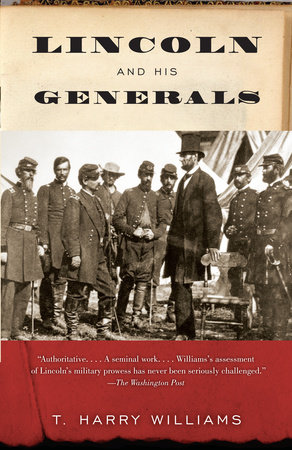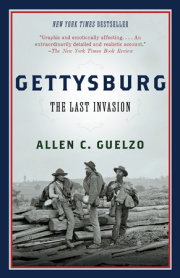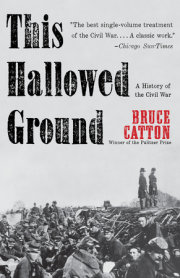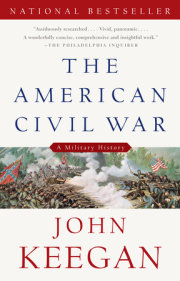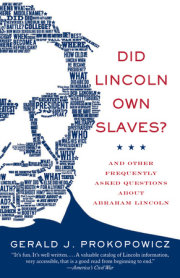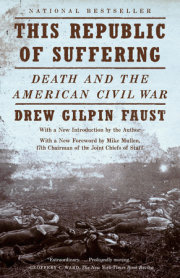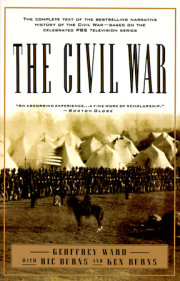Chapter 1
The Pattern of Command
The Civil War was the first of the modern total wars, and the American democracy was almost totally unready to fight it. The United States had in 1861 almost no army, few good weapons, no officers trained in the higher art of war, and an inadequate and archaic system of command. Armies could be raised and weapons manufactured quickly, but it took time and battles to train generals. And it took time and blunders and bitter experiences to develop a modern command system. Not until 1864 did the generals and the system emerge.
In 1861 the general in chief of the army, which at the beginning of the war numbered about 16,000 men, was Winfield Scott. He was a veteran of two wars and the finest soldier in America. But he had been born in 1786, and he was physically incapable of commanding an army in the field. He could not ride, he could not walk more than a few steps without pain, and he had dropsy and vertigo.1 The old General dreamed wistfully of taking the field. "If I could only mount a horse, I–" he would say sadly and pause, "but I am past that."2 He was one of two officers in the army as the war started who had ever commanded troops in numbers large enough to be called an army. The other was John E. Wool, who was two years older than Scott. Wool had been a good soldier in his time, but he too showed the effects of age. He repeated things he had said a few minutes before, his hands shook, and he had to ask his aides if he had put his hat on straight.3 Besides Scott and Wool, not an officer in the North had directed the evolutions of as large a unit as a brigade.4 The largest single army that most of the younger officers had ever seen was Scott's force of 14,000 in the Mexican War.
There was not an officer in the first year of the war who was capable of efficiently administering and fighting a large army. Even Scott, had he been younger and stronger, would have had difficulty commanding anyone of the big armies called into being by the government. All his experience had been with small forces, and he might not have been able to have adjusted his thinking to the organization of mass armies. The young officers who would be called to lead the new hosts lacked even his experience. Not only had they never handled troops in numbers, but they knew almost nothing about the history and theory of war or of strategy. They did not know the higher art of war, because there was no school in the country that taught it. West Point, which had educated the great majority of the officers, crammed its students full of knowledge of engineering, fortifications, and mathematics. Only a minor part of its curriculum was devoted to strategy, and its graduates learned little about how to lead and fight troops in the field. They were equally innocent of any knowledge of staff work: the administrative problems of operating an army or the formulation of war plans. Most of them never learned anything of it in the army, except for those few who could read French or who went abroad.5 They spent most of their army careers fighting Indians or building forts, and there was not much of a staff organization in America for them to get any experience with.
The staff of the army, such as it was, consisted of Scott and the heads of the important departments and bureaus in the military organization-the adjutant general, the quartermaster general, the chief of engineers, the chief of ordnance, and others. Some of these officers were men of ability and would do good work in the war. Their agencies were going concerns with years of experience behind them when hostilities started and needed only to be expanded to meet the larger needs of a larger army. None of the staff chiefs had made any plans for war, and none of them was accustomed to thinking in terms of supplying the needs of mass armies. Some of the departments, notably the quartermaster general's, made the shift from peace to war with efficiency; others never got completely adjusted. All of them were unready for war in 1861, and in that year and even later were not able to furnish field commanders with the technical information or advice or supplies which they were suddenly called on to provide. One of the most ironic examples of American military unreadiness was the spectacle of Northern–and Southern–generals fighting in their own country and not knowing where they were going or how to get there. Before the war the government had collected no topographical information about neighboring countries or even the United States, except for the West. No accurate military maps existed. General Henry W. Halleck was running a campaign in the western theater in 1862 with maps he got from a book store. With frenetic haste, the general set topographical officers and civilian experts to work making maps, but the resulting charts were generally incorrect. Benjamin H. Latrobe, the civil engineer, drew a map for a general going into western Virginia, but the best he could promise was that it would not mislead the expedition. General George B. McClellan had elaborate maps prepared for his Virginia campaign of 1862 and found to his dismay when he arrived on the scene that they were unreliable; "the roads are wrong . . . ," he wailed. Not until 1863 did the Army of the Potomac have an accurate map of northern Virginia, its theater of operations.6 Poor staff work continued in some departments until the end of the war. As late as 1864 there was not an office in Washington that could tell a general organizing a campaign what railroads were under military control, what the condition of their equipment was, or how many men and supplies they could transport.7
In no section of the staff organization was there any person or division charged with the function of studying strategy or formulating war plans for even a theoretical war. The work of the staff was completely technical and routine. Scott, the general in chief, had done no thinking before the war about what strategy should be adopted if war came. He had busied himself chiefly with devising political schemes to avert civil conflict. When the shooting started, he had no strategic design in mind to subdue the South. No other officer had one. Nobody in the army had thought it was important to think of war in strategic terms.
At the head of the American military organization was the president, the commander in chief of all the armed forces of the nation. The man who was president when the war began had been a civilian all his life, had had no military experience except as a militia soldier in a pygmy Indian war, and in 1861 probably did not even know how to frame a military order. The president of the rival nation, the Confederate States, was a graduate of West Point, he had been in the regular army and had seen battle service in the Mexican War. Abraham Lincoln was a great war president; Jefferson Davis was a mediocre one. Nowhere in the history of war is there a better illustration of Clausewitz's dictum that an acquaintance with military affairs is not the principal qualification for a director of war but that "a remarkable, superior mind and strength of character" are better qualifications.8
With no knowledge of the theory of war, no experience in war, and no technical training, Lincoln, by the power of his mind, became a fine strategist. He was a better natural strategist than were most of the trained soldiers. He saw the big picture of the war from the start. The policy of the government was to restore the Union by force; the strategy perforce had to be offensive. Lincoln knew that numbers, material resources, and sea power were on his side, so he called for 400,000 troops and proclaimed a naval blockade of the Confederacy. These were bold and imaginative moves for a man dealing with military questions for the first time. He grasped immediately the advantage that numbers gave the North and urged his generals to keep up a constant pressure on the whole strategic line of the Confederacy until a weak spot was found–and a break-through could be made. And he soon realized, if he did not know it at the beginning, that the proper objective of his armies was the destruction of the Confederate armies and not the occupation of Southern territory. His strategic thinking was sound and for a rank amateur astonishingly good.9
During the first three years of the war, Lincoln performed many of the functions that in a modern command system would be done by the chief of the general staff or by the joint chiefs of staff. He formulated policy, drew up strategic plans, and even devised and directed tactical movements. Judged by modern standards, he did some things that a civilian director of war should not do. Modern critics say that he "interfered" too much with military operations. He and his contemporaries did not think that he interfered improperly. In the American command system it was traditional for the civilian authority to direct strategy and tactics. The Continental Congress in the Revolution and the president and cabinet in the War of 1812 and the Mexican War had planned extensive and detailed campaigns. Lincoln was acting only as the civil authority had acted in every previous war. He was doing what he and most people thought the commander in chief ought to do in war.
Sometimes Lincoln made excellent plans and decisions; sometimes he made bad mistakes. Some of his mistakes resulted from his initial ignorance in 1861-62 of how to translate his strategical concepts into workable instructions for his generals. His first generals, especially McClellan, were equally ignorant of how to establish relations with the head of the government so that they could find out his ideas about strategy and counsel him. When Lincoln asked them for advice, he usually got
ipse dixit opinions. McClellan, who succeeded Scott as general in chief, did not seem to know that he ought to offer guidance to his political chief.1 If McClellan and other generals had known how to talk to Lincoln or had wanted to talk with him about the military situation, the President would have interfered in military affairs less than he sometimes did. On several occasions, he intervened because the generals had not frankly told him what they were going to do or had not explained their purposes to him in terms that he could understand. Sometimes Lincoln "interfered" without meaning to. He had the type of mind that delighted to frame a plan of military operations. He loved to work up a plan and spring it on a general. The mental exercise gave him pleasure, and he liked to get the reactions of soldiers to his schemes. He did not mean for the generals to adopt his designs, but they did not always understand this. What he intended as a presentation of his ideas or a suggestion to be considered sometimes came through to the military mind as an order from the commander in chief.2
Much of Lincoln's so-called interfering with the conduct of the war occurred in the first years of the conflict, when he believed, with some reason, that he was more capable of managing operations than were most of the generals. When the war started, he was inclined to defer to the judgments of trained soldiers. He soon came to doubt and even scorn the capabilities of the military mind. He asked of the generals decision, action, fighting, victory. They replied with indecision, inaction, delay, excuses. He became oppressed by the spectacle, so familiar in war, of generals who were superb in preparing for battle but who shrank from seeking its awful decision. "'Tell him," he wrote in preparing instructions for one general, "to put it through–not to be writing or telegraphing back here, but put it through."3 He wanted victories, but he got more letters than victories, letters from generals who wrote back that they could not put it through unless Lincoln provided them with more men and more guns . . . and still more.
One of the most important functions Commander in Chief Lincoln had to perform was choosing generals to manage the armies. He never had to worry that too few would apply for commissions. At the beginning of the war especially, he was showered with requests and demands for appointments from would–be generals and their political and military supporters: from officers who had spent weary years in the regular army in junior rank and now saw a chance to get their stars; from former officers who had resigned from the army to take lucrative civilian jobs and now wanted to return as generals; from politicians who thought military heroes would be popular after the war; from men who were ambitious, patriotic, able, mediocre, and incompetent. The rush for rank impressed, amused, and irritated the President. A popular jest of the war, one with a bitter undertone, was his reported remark about a brigadier general who got himself captured along with some horses and mules: "I don't care so much for brigadiers; I can make them. But horses and mules cost money."4
1 Winfield Scott to Simon Cameron, October 31, 1861,
War of the Rebellion . . . the Official Records of the Union and Confederate Armies, Sera 3, I, 611. Hereafter cited as
Official Records; unless otherwise noted, all citations are to Ser. 1.
2 Frederick W. Seward,
Reminiscences of a War-Time Statesman and Diplomat) 183o-1915, 167-168.
3 Henry M. Flint to Frederic Hudson, September 10, 1862, James Gordon Bennett MSS.
4 Charles W. Elliott,
Winfield Scott: The Soldier and the Man, 718.
5 Arthur Latham Conger, "President Lincoln as War Statesman,"
Wisconsin Historical Publications, Proceedings, 1916, 12; Jacob Dolson Cox,
Military Reminiscences of the Civil War, I, 177-180.
6 Henry W. Halleck to D. C. Buell, February 13, 1862,
Official Records, VII, 609; B. H. Latrobe to Frederick W. Lander, January 4, 1862, Lander MSS.; George B. McClellan,
McClellan's Own Story, 253, 264; Emerson Gifford Taylor,
Gouverneur Kemble Warren . . . , 106–107.
7 Herman Haupt to Lincoln, January 16, 1864, the Robert Todd Lincoln Collection of the Papers of Abraham Lincoln, vol. 138. Hereafter cited as Lincoln MSS.
8 Karl von Clausewitz,
On War, 599, Modern Library Edition.
9 Colin R. Ballard,
The Military Genius of Abraham Lincoln: An Essay) 2-3, 6, 28-29, 239; John C. Ropes,
The Story of the Civil War, I, 111.
1 Sir Frederick Maurice, "Lincoln as a Strategist,"
Forum, LXXV, 1926, 164.
2 Sir Frederick Maurice,
Statesmen and Soldiers of the Civil War, 95-96.
3 Lincoln to Simon Cameron, June 20, 1861, John G. Nicolay and John Hay (eds.),
The Complete Works of Abraham Lincoln, VI, 294. Hereafter cited as
Works of Lincoln.
4. James Harrison Wilson,
Under the Old Flag, I, 349.
Copyright © 2011 by T. Harry Williams. All rights reserved. No part of this excerpt may be reproduced or reprinted without permission in writing from the publisher.

